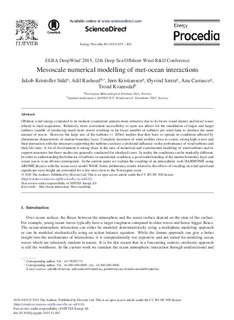| dc.contributor.author | Süld, Jakob Kristoffer | |
| dc.contributor.author | Rasheed, Adil | |
| dc.contributor.author | Kristiansen, Jørn | |
| dc.contributor.author | Sætra, Øyvind | |
| dc.contributor.author | Carrasco, Ana | |
| dc.contributor.author | Kvamsdal, Trond | |
| dc.date.accessioned | 2018-01-23T09:21:23Z | |
| dc.date.available | 2018-01-23T09:21:23Z | |
| dc.date.created | 2015-12-09T18:04:16Z | |
| dc.date.issued | 2015 | |
| dc.identifier.citation | Energy Procedia. 2015, 80 433-441. | nb_NO |
| dc.identifier.issn | 1876-6102 | |
| dc.identifier.uri | http://hdl.handle.net/11250/2478948 | |
| dc.description.abstract | Offshore wind energy compared to its onshore counterpart appears more attractive due to its lesser visual impact and lesser issues related to land acquisition. Relatively more convenient accessibility to open sea allows for the installation of larger and larger turbines capable of producing much more power resulting in far lesser number of turbines per wind farm to produce the same amount of power. However, the large size of the turbines (≈ 200m) implies that they have to operate in conditions affected by phenomena characteristic of marine boundary layer. Complete inversion of wind profiles close to coasts, strong high waves and their interaction with the structures supporting the turbines can have a profound influence on the performance of wind turbines and their life time. A lot of development is taking place in the area of numerical and experimental modeling of wind turbines and its support structures but those studies are generally conducted for idealized cases. In reality the conditions can be markedly different. In order to understanding the behavior of turbines in operational condition, a good understanding of the marine boundary layer and ocean waves is an obvious prerequisite. In the current paper we explain the coupling of an atmospheric code HARMONIE using AROME physics with the ocean wave model WAM. Some preliminary results related to the effects of coupling on wind speed and significant wave height are presented for a few sites close to the Norwegian coast. | |
| dc.language.iso | eng | nb_NO |
| dc.rights | Attribution-NonCommercial-NoDerivatives 4.0 Internasjonal | * |
| dc.rights.uri | http://creativecommons.org/licenses/by-nc-nd/4.0/deed.no | * |
| dc.subject | CFD | |
| dc.subject | Vindkraft | |
| dc.subject | Wind power | |
| dc.subject | Hav-atmosfære vekselvirkning | |
| dc.subject | Air-sea interaction | |
| dc.subject | Dynamisk meteorologi | |
| dc.subject | Dynamic meteorology | |
| dc.title | Mesoscale numerical modelling of met-ocean interactions | nb_NO |
| dc.type | Journal article | nb_NO |
| dc.type | Peer reviewed | nb_NO |
| dc.description.version | publishedVersion | |
| dc.subject.nsi | VDP::Matematikk og naturvitenskap: 400 | |
| dc.subject.nsi | VDP::Mathematics and natural scienses: 400 | |
| dc.source.pagenumber | 433-441 | nb_NO |
| dc.source.volume | 80 | nb_NO |
| dc.source.journal | Energy Procedia | nb_NO |
| dc.identifier.doi | 10.1016/j.egypro.2015.11.447 | |
| dc.identifier.cristin | 1298996 | |
| dc.relation.project | Norges forskningsråd: 216465 | nb_NO |
| cristin.unitcode | 7401,90,11,0 | |
| cristin.unitname | Anvendt matematikk | |
| cristin.ispublished | true | |
| cristin.fulltext | original | |
| cristin.qualitycode | 1 | |

